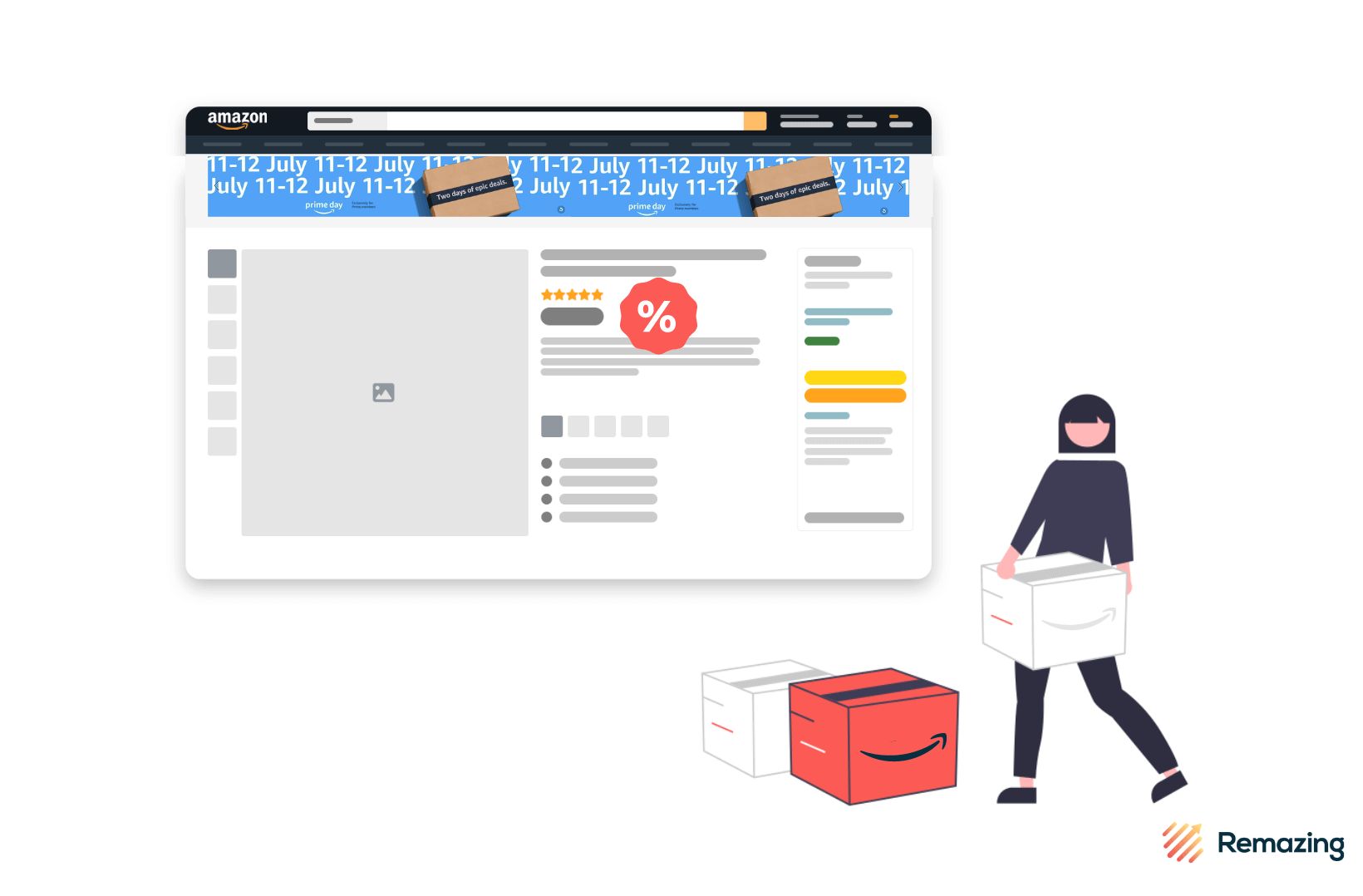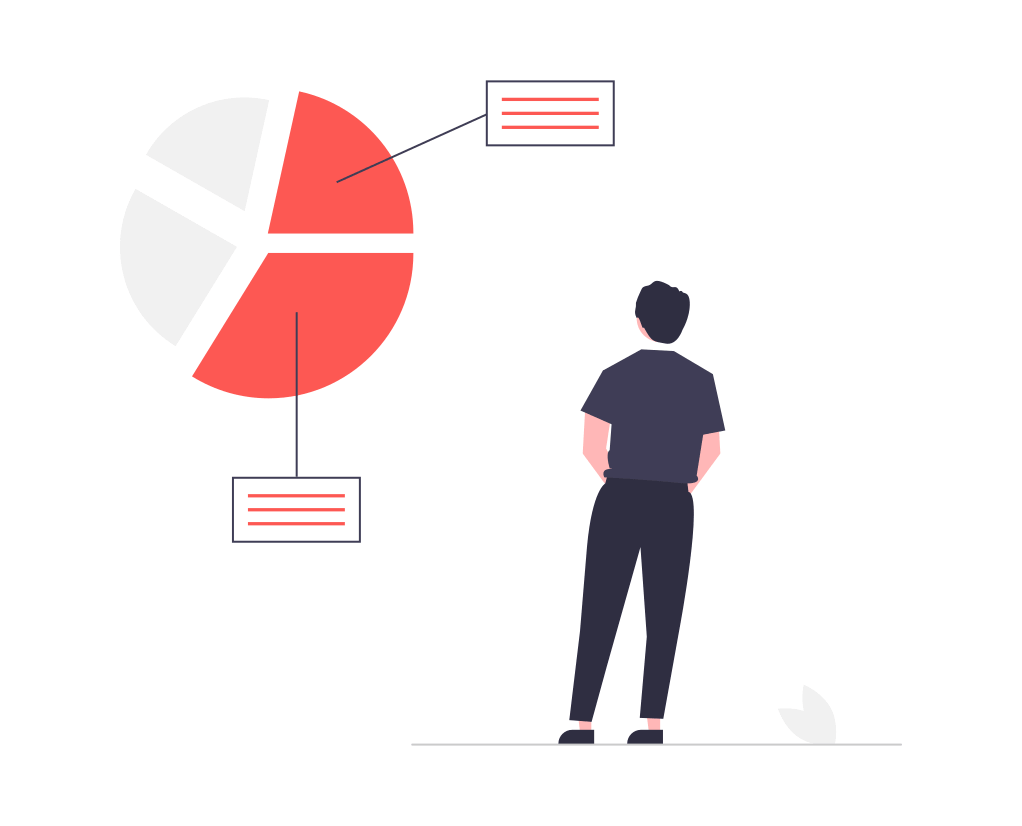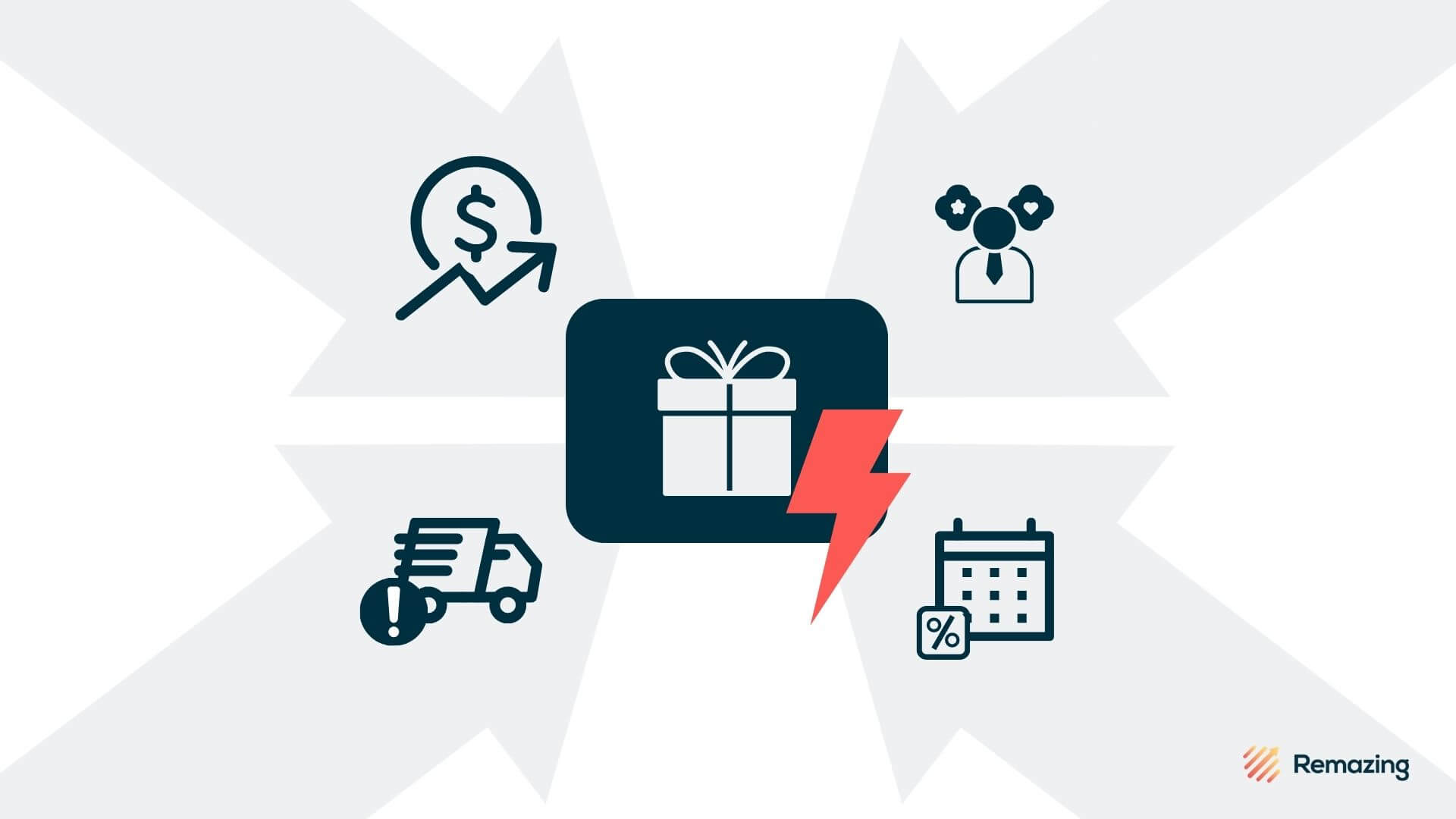
Prime Day 2022: Tips for Brands on Amazon

Amazon’s Prime Day is once again right around the corner and just like in the past, it will most likely be one of the biggest e-commerce events of the year. To maximize sales also in 2022, a thorough preparation and the right Amazon marketing strategy are crucial.
Prime Day 2022: Timing & Challenges
This year, Amazon’s popular online shopping event will take place on July 12 and 13. It seems as if the e-commerce giant wants to live up again to the event’s success in the past by moving it back to the first month of Q3 as it used to be. Due to the exceptional challenges of the COVID-19 pandemic, Prime Day was moved to October two years ago, and in 2021 it already took place in June. In any case, moving Amazon’s special event back to July should help to strengthen a quarter that is usually rather weak due to the summer holiday season.
Even if the date of Prime Day 2022 returns to normal, the current year is anything but easy in terms of the global economic situation. After the Russian invasion of Ukraine at the end of February and renewed lockdowns in China, global supply chains are under more pressure than ever. With the highest inflation rates in the United States in 40 years at 8.6%, the general conditions for online retailers are anything but optimal for this year’s Prime Day. Increasing pressure on margins due to higher delivery costs and rising inflation makes it difficult to offer the discounts demanded by Amazon without incurring heavy operating losses. Inflation is also causing many customers to cut back on non-essential products, which in turn is affecting retailers. For these reasons, some vendors and sellers plan to keep the discount significantly lower than last year – or not participate at all with deals on Prime Day. Other Amazon merchants are now even more eager to take advantage of the deal event with deep reductions to sell off their pent-up inventory.
All in all, as every year, the deal event offers various opportunities to attract new customers and further retain existing ones. Even if the desired profit is not achieved at the time of Prime Day itself, the event still promises long-term awareness and branding effects.
Prime Day 2021: A Look Back
Last year’s deal event was deemed by Amazon as the most successful Prime Day in the company’s history. What was new in 2021 was that the deal event took place over a span of two days (June 21 and 22). Additionally, it already took place in the second quarter of the year for the first time. The reason Amazon stated for this was that the classic Prime Day date in July fell right in the middle of the vacation season in many countries. According to the e-commerce giant, it was better for online shoppers and sellers to have the event take place before the annual school holidays started.
In an analysis last year, we evaluated the results of Prime Day 2021 in the EU5 markets of Germany, the UK, France, Italy and Spain, based on over 72,000 products across all categories. We have summarized the most important points again below:
More sales on the first day of Prime Day
The sales increase on the two days of Prime Day compared to the respective day of the previous week was on average +420% on the first day and +178% on the second day. The first day of Prime Day 2021 was everywhere significantly more successful than the second one – except in France. On the German marketplace, sales on the first day of Prime Day were 2.5x higher than on the second day.
Sales on both days of Prime Day vs. Previous Weeks
Within the e-commerce industry, there is often a fear of a drop in sales after Prime Day took place. However, our analysis from last year shows that this is not necessarily the case. Brands that used deals saw 10% more sales in the week after Prime Day than the week before Prime Day, while brands that forewent deals saw a -19% loss in sales compared to the week before the sales event.
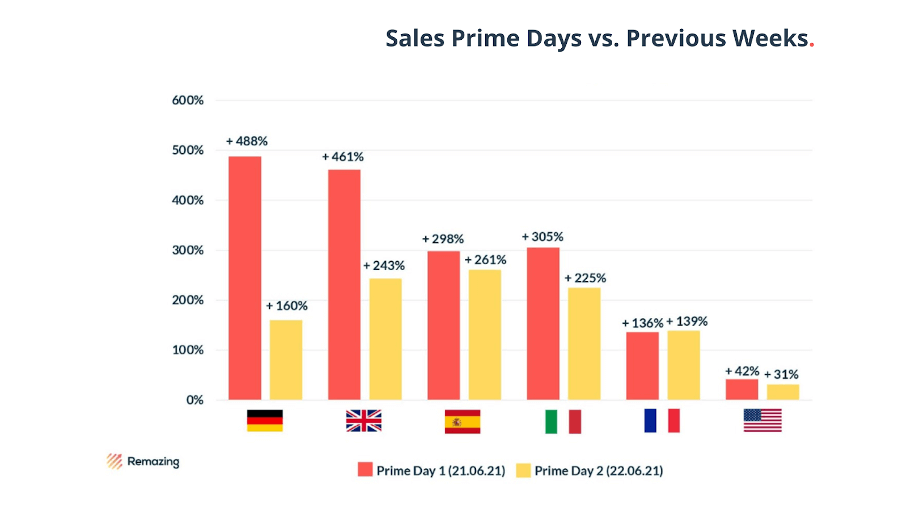
Advertising: Prime Day Ad Spend & CPC
Ad spending averaged 217% higher on the first day of Prime Day in 2021 and 168% higher on the second day compared to an average day within the same month. This meant that the two deal days generated 15% of all impressions for the entire month. CPC was 33% higher on the first deal day, and 39% higher on the second day, than on an average day during the month.
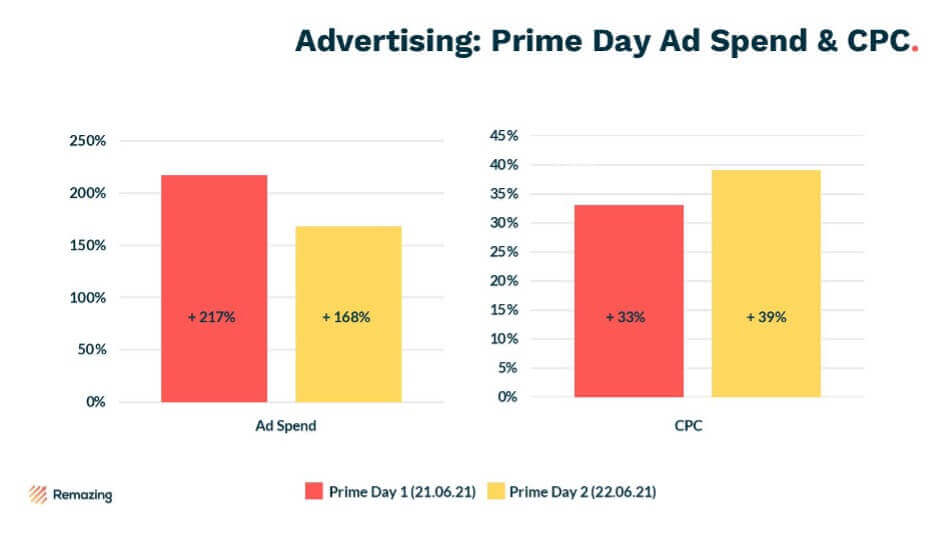
Our Recommendations for Prime Day 2022
Since there are two days of Prime Day again this year, brands should primarily focus on the first day of the event. In 2021, the sales increase was higher on the first day with a lower CPC than seen on the second day. Customers seem to act quickly on good deals rather than waiting longer than necessary to make a purchase decision. In addition, brands and retailers should make use of placing deals during Prime Day, as they continue to benefit from the positive effect in the long term, even after the sales event.
Actions for Prime Day
As it does every year, Amazon receives an onslaught of new users signing up for the platform during Prime Day. To create an optimal customer experience, Amazon has clear requirements: on the one hand, prominent brands and sales-driving categories should be shown directly on the home page, and on the other hand, results in searches should be filled with ‘‘Prime Day deals’’. Offers that are tagged with the popular ‘‘Prime Day offer’’ label must be coordinated with Amazon and stocked with sufficient inventory.
As a first step in strategic planning, it is a good idea to look at Prime Day from the consumer’s perspective. Customers have learned from past experiences that lots of products are discounted on Prime Day. More expensive purchases are often postponed so they can be made at a lower price during the deal event. However, consumers usually also make additional smaller impulse purchases. While a customer journey on Amazon normally starts with a search, it can be assumed that customers are more inspired by the special offer pages and are also more likely to click on advertisements due to their interest in discounts during Prime Day. For this reason, we recommend every seller to look into potential deals in time and, if possible, take advantage of them to ensure product visibility. In the following, we will look at how brands can best prepare for the two event days in 2022 and what is important for the preparation as well as during Prime Day and afterwards.
Before Prime Day
Retail Readiness Score
In order to best benefit from the increased traffic during Prime Day on Amazon, all product detail pages should ideally be optimized, which leads to a higher click-through rate (CTR) and conversion rate (CR).
We measure the level of optimization using the Retail Readiness Score that our Amazon tool Remdash provides. KPIs such as the length of the title, the number of bullet points and images, as well as ratings and reviews are taken into account and weighted according to importance.
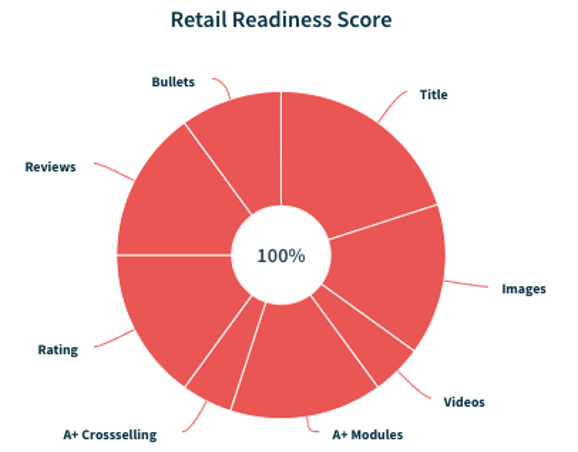
In addition, the content should also be qualitatively optimized. Particularly including SEO-relevant keywords in the title, bullet points, and product description as well as meaningful, informative pictures in product description pages are essential for good findability and sales conversion rates.
Selection of Products and Deals
When selecting products for Prime Day deals, retailers should ask themselves several questions:
- Which of my products are not currently experiencing logistics problems and are not expected to during Prime Day?
- Is the inventory level high enough?
- Which of my best sellers can be sales drivers during Prime Day?
- Which of my new products or long-tail products can I promote during Prime Day to give them more visibility in the long run?
Important for Vendor customers: Amazon gets involved in the selection of products and makes suggestions as to which products are suitable for Prime Day. These are sold to Amazon with a discount on the actual purchase price. As a vendor, you should review these suggestions and determine whether you can reconcile the proposed discount with your margin and profit planning.
Prime Day is all about the exceptional deals on Amazon, which are also featured on their respective Amazon pages, giving them additional traffic. These deals usually have to give a minimum discount of 20%. The duration of the deals is agreed with Amazon and can be up to 48 hours. It is important to know the exact time periods here, as the time of the deals has a significant impact on the results. For example, our experience shows that deals during the evening hours are more attractive than deals in the morning or at night.
There is also the possibility to benefit from the increased traffic on Amazon’s platform with ‘‘normal deals’’. The deadline for self-service lightning deals for Vendors and Sellers was already on May 13, 2022. Vendors still have the option to create their own deal with the Amazon Vendor Services (AVS) team though. These Prime Day deals must typically offer a discount of at least 20%. Using self service, Sellers can also include lightning deals along with Prime Day deals during the limited time window of the sales event. For selected Sellers with an Amazon Account Manager, there is also the option to offer Top Deals (former ‘‘Deals of the Day’’). The time period in which offers can be created via Amazon varies and should definitely be discussed with one’s respective contact person at Amazon.
Plan and Create Advertising Campaigns
Traffic on Amazon sharply increases before Prime Day, which is why it should be ensured that a company’s products are visible well before the deal event – even if consumers may only be gathering information and will wait before making a purchase. Amazon’s own marketing strategy and goals for Prime Day are strongly related to whether Prime Day offers are participated in. Depending on the goals and the number of products in deals, a decision can then be made about increasing the budget as well as the bids.
The various advertising options via Sponsored Ads and Amazon DSP can also give an additional boost to the products that are promoted via special Prime Day offers. In the following, we will briefly go over the different types of advertising:

Subscribe to our newsletter now and receive regular updates on Amazon and other online marketplaces.
Subscribe to the newsletter now.
- Sponsored Products:
Instead of creating new campaigns for Prime Day, it is better to expand campaigns that already exist. Due to historical data on the used keywords, these campaigns tend to perform better than newly created campaigns. Additionally, automated campaigns are useful to bridge the possibly missing Amazon history and to highlight the products in Amazon deals. To make deal products as visible as possible, Sponsored Product Ads especially integrate ASINs with deals.
Tip: Additionally, keywords such as ‘‘offer’’, ‘‘deal’’ or ‘‘Prime Day’’ can be included – but only if these products are also provided in Prime Day offers.
- Sponsored Brand Ads:
Again, the more historical data a campaign has, the better. Campaigns that link directly to the offers page in the Brand Store are ideal here. Once these campaigns are created, they can always be reactivated for other Amazon deal events.
- Sponsored Display Ads:
To protect one’s PDPs from competition and prevent visitors to your product from clicking on a competitor’s product through a Sponsored Display (SD) campaign, brands should utilize SD campaigns. This way, PDPs are matched with similar products and these are then used for cross-selling or up-selling. In addition, similar products of one’s competition can be paired with deal products to generate interest and additionally attract customers.
- Amazon DSP:
The weeks before Prime Day offer a great opportunity to generate awareness and visibility for one’s product portfolio. With DSP campaigns, relevant target groups on and off Amazon can be targeted and directed to the PDP or the relevant brand store page with the help of appealing creatives and call-to-actions.
We recommend increasing the playout frequency of the line item to 8x per day. Also, brands can maximize reach by using as many creative formats (e.g. desktop, mobile web or mobile app: dynamic eCommerce, responsive eCommerce, video) and placement options (e.g. 720×90, 160×600, 300×250, 320×50) as possible. The limiting viewability levels in line items can be removed under “Amazon viewability” by selecting “Allow all”.
Tip: Creatives are automatically paused in Amazon DSP when a product is out of stock and can be reactivated once ASINs are back in stock. However, such a reactivation is not automated and must be done manually!
Expand Brand Store and Images with ‘‘Prime Day Content’’
In order to simplify the search for products with deals for Amazon customers and to organize all Prime Day brand deals, a “Deals” subpage should be created in the Brand Store. Ideally, this tab is located directly after the home page to be as visible and easily accessible as possible. Additionally, Prime Day specific images or banners can be created for both the Brand Store and the PDP.
Ideally, brands can already include a banner for Prime Day on the homepage of their own brand store, which then leads to the “Offers” subpage so that potential customers do not have to search for the page unnecessarily. Ideally, this banner should include a call-to-action button.
During Prime Day
Check Stock
It is important to regularly check the stock of advertised products during Prime Day. Even if it is no longer possible to send larger quantities to an Amazon warehouse in the short term, conclusions can still be drawn for the planned ads. Products that in all likelihood will no longer be in stock for long should therefore only be advertised with a lower budget or not at all. Deals could even be harmful here if an already scarce product is advertised too strongly and it is thus possibly ‘out of stock’ during Prime Day. On the other hand, products with lower historical sales, which have a high stock level and whose sales you want to promote, could be advertised more on Prime Day.
Adjust the Budgets of the Advertising Campaigns
Here, we recommend ramping up campaign budgets at two strategically important times:
- When a brand’s Prime Day deals are active.
- When no own deals and no “competitor deals” are active outside of Prime Day and lightning deals.
Adjust Keywords
For campaigns with discounted products, it pays off to use keywords such as “offer”, “deal” and “Prime Day” during the period of the offer, which often appear in the most searched terms during the event days.
Customize Advertising Media
Ensure that products promoted with deals are played out preferentially in Sponsored Product and Sponsored Display campaigns. In Sponsored Brands campaigns, the products on sale should definitely be displayed in the first two placements, as this is the only place where the “Offer of the Day” label appears – which is a major click and performance driver.
After Prime Day
Extend Advertising Activities
It is advisable to allocate a slightly increased advertising budget for the period after Prime Day as well. For example, you can use sponsored display or Amazon DSP campaigns to target users who bought your products during Prime Day and show them a complementary product.
Measuring Results
We recommend looking closely at the specific results of the deals and advertising activities to measure and quantify their success and contribution. In addition, it should be observed whether participation in the Prime Day offers had a positive halo effect on a brand. For this purpose, it is worth evaluating, for example, whether consumers search for the brand more frequently after Prime Day. This is possible with Amazon’s “Search Term Report” or can be measured by means of impressions of advertising campaigns containing brand keywords.
Furthermore, Prime Day deals can lead to products performing better in the organic ranking on Amazon due to increased sales. Glance views or the bestseller rank of the products are a good indicator for this. In our tool Remdash, we also use the “Share of Voice” metric for the analysis, which reveals the share of own products in the search results at keyword level.
Document Learnings
One can say: “After Prime Day is before Black Friday”. In general, the next big deal event on Amazon is only a matter of time. Therefore, we urge all brands to track and analyze KPIs used to define and measure the success of their Prime Day activities. The goal here is to increase internal efficiencies, and encorporate results and learning for the next deal events in the long term.
Bottom Line: Start preparing ad campaigns and activities around Prime Day 2022 now!
After the success of other deal events on Amazon in the past, it can be assumed that this year’s Prime Day will also cause quite a positive stir and drive up sales on the platform.
Sufficient preparation and an Amazon marketing strategy that matches one’s brand’s goals for the weeks before and during Prime Day are crucial for success. However, even after Prime Day, it is worth measuring and analyzing the achieved results, extending advertising campaigns beyond the deal event, and documenting one’s learnings to prepare even better for new Amazon events in the future.
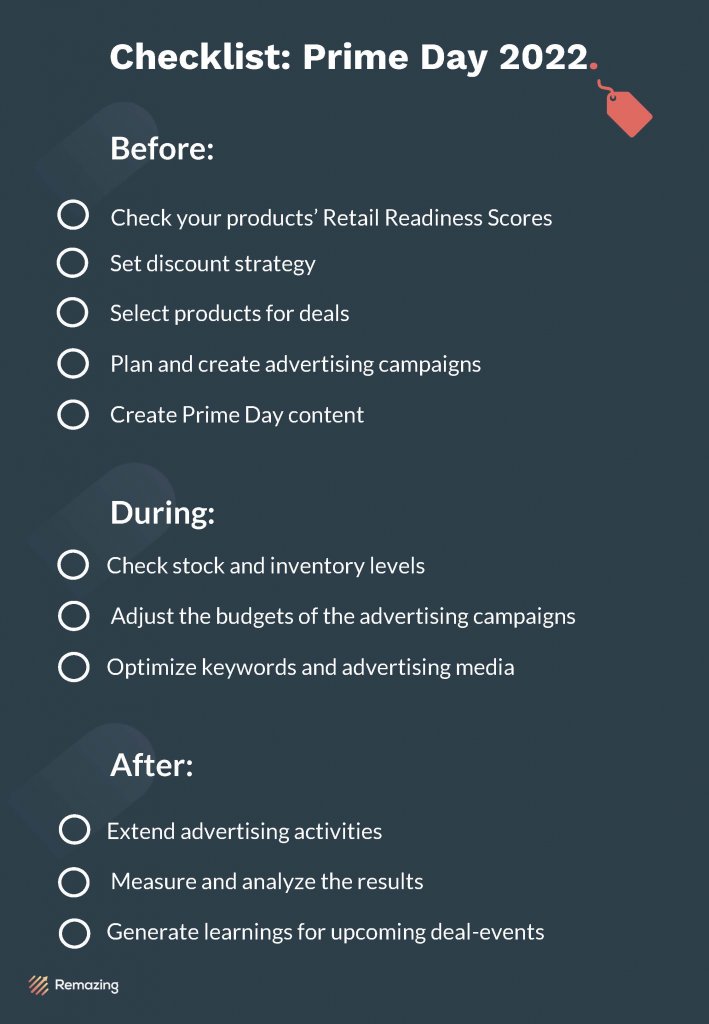
Are you interested in an expert analysis of your Amazon account?
Request free analysisRemazing GmbH
Brandstwiete 1
20457 Hamburg
©Remazing GmbH
